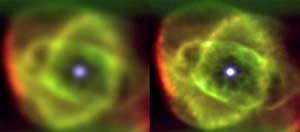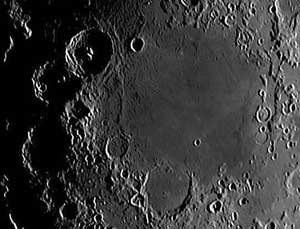Often the simplest ideas are the best ones...
From
MS/NBC:
A Heavenly View
New and relatively cheap telescope technology is putting the universe into incredibly sharp focus. Is the Hubble being rendered obsolete?
Can a $20,000 camera coupled to a 60-year-old telescope shoot sharper images than the $1.5 billion Hubble Space Telescope? Absolutely, say astronomers from the University of Cambridge and the California Institute of Technology.
To prove their point they suggest looking at the top of the Mount Palomar Observatory near San Diego. This summer a team from both universities grafted their �Lucky imaging� system onto the observatory�s Hale Telescope and aimed it at M13, a star cluster that�s 25,000 light years away. The results were much better than they expected. �What we�ve done for the first time is produce the highest-resolution [images] ever taken--and we took them from the ground,� says Craig Mackay of Cambridge�s Institute of Astronomy, who led the team. �We are getting twice the resolution of Hubble.�
That�s no small task. While the heat and water vapor in the Earth�s atmosphere make stars seem to sparkle, their blurring effect also severely limits the image clarity of ground-based telescopes. Eliminate the atmosphere, and the view from an observatory would be 20 times clearer.
Getting past the atmosphere was the reason space-based telescopes like the Hubble were created. And for the past 17 years, the images it has produced have dropped jaws and raised the standard in astronomical imaging.
But then astronomers at Cambridge and Caltech got �Lucky.� To create their system they made the most of an existing technology, adaptive optics, and enhanced it with a super-high-speed digital camera that�s capable of shooting 20 images every second, says Nicholas Law, a Caltech postdoctoral scholar who worked on the Lucky project.
Adaptive optics is a way of correcting the atmosphere�s distortion of light as it enters the telescope. A sensor measures the distortion and corrects most of it using a flexible mirror that shifts the light back into straight lines. Then the Lucky camera shoots in rapid-fire fashion, and astronomers select the images that capture moments when atmospheric distortion is minimal.
The reporting is a bit hyperbolic as although it does offer an amazing increase in ground-based resolution, it doesn't begin to compete with what Hubble does best which is far dim objects. Taking rapid-fire exposures limits you to short exposure times and bright objects. Hubble (and other ground-based scope exposures) deal with exposure times upwards of hours - they capture a lot of the fine dim details that this system simply cannot.
That being said, the results are pretty spiffy:

Wikipedia has a good explanation:
Lucky imaging
And backyard astronomers can do it with cheap webcams and free software (because you are stacking multiple exposures, the overall resolution becomes much higher than the cheap webcam).
Check out
here,
here,
here and
here
Here is an image of the Moon perfect subject for this technology)taken with a 0.8M Pixel webcam:

Cool stuff!!!


